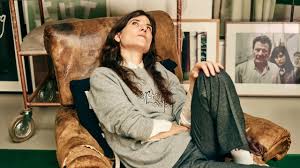
Sigmund Freud, in an essay from 1913 on the nascent practice of psychoanalysis, argued for “a certain ceremonial observance” in the configuration of a consulting room. “I adhere firmly to the plan of requiring the patient to recline on a sofa, while one sits behind him out of sight,” he wrote. This arrangement conveniently spared the analyst—“I cannot bear to be gazed at for eight hours a day,” Freud remarked—while allowing the patient to speak without inhibition. Supine on a Persian-rug-draped couch, Freud’s patients were instructed to say whatever came to mind, “as if you were sitting at the window of a railway train and describing to someone behind you the changing views you see outside.”
Bella Freud, a great-granddaughter of Sigmund Freud, hasn’t read much of her illustrious ancestor’s work, though she did once get halfway through “The Interpretation of Dreams.” She has, however, benefitted from years of therapy based on the insights of psychoanalysis, including the notion that a particular kind of talking can lead to relief from burdensome ways of being. She recently said of seeing a therapist, “I like having someone that’s got my back—someone for myself. And then there is ‘Oh, my God, why am I still doing this? Or why do I still feel like that?’ ”
For more than three decades, Freud, who lives in London, has run an eponymous fashion label, whose distinctive aesthetic spans three-piece pants suits, button-up shirts with Peter Pan collars, and knits with unusual slogans (“GINSBERG IS GOD”). The line is calculated to appeal to a clientele of women rather like Freud herself—bohemian, elegant, subtle, ironical. Occasionally, her creations whimsically allude to her weighty intellectual inheritance, as with a T-shirt bearing the words “Fashion Neurosis” or a scent called Psychoanalysis (featuring, inevitably, tobacco flower). A few years ago, when she was in her late fifties, she was seized by a longing to move beyond clothes and experiment with the art of conversation: a TV show, or perhaps an online-video series, inspired by the kinds of confidences traded behind the scenes at fashion shows or in the corners of parties. After several false starts—the pandemic didn’t help—the project became an obsession. “I thought, If I don’t do this, I will die, actually—I will go to my grave thinking there was something that I really wanted to do and I never did,” she told me.
